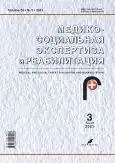Клинико-экспертный случай при сочетании синдромов Саула–Вильсона и Рубинштейна–Тейби
- Авторы: Рябоконь А.Г.1, Доронина О.Е.1
-
Учреждения:
- Главное бюро медико-социальной экспертизы по Ленинградской области
- Выпуск: Том 24, № 3 (2021)
- Страницы: 63-70
- Раздел: Практическому врачу
- URL: https://journals.rcsi.science/1560-9537/article/view/81457
- DOI: https://doi.org/10.17816/MSER81457
- ID: 81457
Цитировать
Аннотация
Синдром Саула–Вильсона, как и синдром Рубинштейна–Тейби, в соответствии с современной классификацией относят к редким генетическим болезням. Так, на сегодняшний день в литературных источниках имеется описание 16 больных из разных стран.
Для синдрома Саула–Вильсона характерны сочетание нанизма, патологии длинных трубчатых костей, позвоночника и органа зрения, типичные дизморфические черты строения лица и рентгенологические данные; для синдрома Рубинштейна–Тейби ― разнообразные пороки скелета (низкий рост, расширение фаланг пальцев, полидактилия на ногах, деформации лица и черепа, высокое арковидное нёбо, изменение формы и положения ушных раковин, расширенные фаланги пальцев, лордоз, кифоз, сколиоз), косоглазие, аномалии рефракции, нарушения со стороны внутренних органов, нарушения интеллектуального и физического развития.
В статье представлен сложный клинико-экспертный случай при сочетании двух генетических болезней ― синдромов Саула–Вильсона и Рубинштейна–Тейби, типичными проявлениями которых стали видимые черепно-лицевые дисморфии, изменения со стороны костно-мышечной системы в виде прогрессирующего двустороннего коксартроза, нестабильности грудного отдела позвоночника, деформации стоп, сопровождающиеся выраженными нарушениями нейромышечных, скелетных и статодинамических функций. Многосистемное поражение организма вызвало затруднение у специалистов при проведении медико-социальной экспертизы. Указанные нозологические формы отсутствуют в действующих классификациях и критериях установления инвалидности, в связи с чем количественная оценка стойких функциональных нарушений проводилась индивидуально ― по наличию степени выраженности нарушенных функций, их сочетанию и влиянию друг на друга.
Применение современных методов диагностики, в том числе генетических исследований, при наследственных заболеваниях позволяет на раннем этапе установить диагноз, определить тактику ведения детей с целью обеспечения своевременного патогенетического лечения, в том числе хирургического, предупреждения развития тяжёлых осложнений, функциональных нарушений. Успехи медицины позволяют не только существенно улучшить качество жизни этой категории детей, но и увеличить их продолжительность жизни. Так как в большинстве случаев наследственные заболевания с вовлечением опорно-двигательного аппарата сопровождаются стойкими нарушениями функций организма и приводят к инвалидности, классификации и критерии установления инвалидности должны включать количественную оценку степени нарушенных функций при врождённых аномалиях и наследственных заболеваниях.
Полный текст
Открыть статью на сайте журналаОб авторах
Анна Григорьевна Рябоконь
Главное бюро медико-социальной экспертизы по Ленинградской области
Автор, ответственный за переписку.
Email: ryabokon.ag@lomse.ru
ORCID iD: 0000-0003-4887-4404
SPIN-код: 4296-0934
к.м.н., с.н.с.
Россия, 195197, Санкт-Петербург, Полюстровский пр-кт, д. 43 лит. АОльга Евгеньевна Доронина
Главное бюро медико-социальной экспертизы по Ленинградской области
Email: doronina.oe@lomse.ru
SPIN-код: 1103-4158
Россия, 195197, Санкт-Петербург, Полюстровский пр-кт, д. 43 лит. А
Список литературы
- Маркова Т.В., Кенис В.М., Мельченко Е.В., и др. Клинико-генетические характеристики и ортопедические проявления синдрома Саула-Вильсона у двух российских больных // Ортопедия, травматология и восстановительная хирургия детского возраста. 2020. Т. 8, № 4. С. 451–460. doi: 10.17816/PTORS33826
- Ferreira C.R., Xia Z.J., Clement A., et al. A recurrent de novo heterozygous COG4 substitution leads to Saul-Wilson syndrome, disrupted vesicular trafficking, and altered proteoglycan glycosylation // Am J Hum Genet. 2018. Vol. 103, N 4. Р. 553–567. doi: 10.1016/j.ajhg.2018.09.003
- Ferreira C.R., Zein W.M., Huryn L.A., et al. Defining the clinical phenotype of Saul-Wilson syndrome // Genet Med. 2020. Vol. 22, N 5. Р. 857–866. doi: 10.1038/s41436-019-0737-1
- Rubinstein J.H., Taybi H. Broad thumbs and toes and facial abnormalities. A possible mental retardation syndrome // American Journal of Diseases of Children. 1963. Vol. 105. P. 588–608.
- Приказ Министерства труда и социального развития Российской Федерации от 27.08.2019 № 585н «О классификациях и критериях, используемых при осуществлении медико-социальной экспертизы граждан федеральными государственными учреждениями медико-социальной экспертизы». Режим доступа: https://www.garant.ru/products/ipo/prime/doc/72921006/. Дата обращения: 18.08.2021.
- Постановление Правительства Российской Федерации от 20 февраля 2006 г. № 95 «О порядке и условиях признания лица инвалидом». С изменениями и дополнениями, вступившими в силу 26 ноября 2020 г. Режим доступа: https://base.garant.ru/12145177/. Дата обращения: 18.08.2021.
- Приказ Министерства труда и социального развития Российской Федерации от 27.12.2017 № 888н «Об утверждении перечня показаний и противопоказаний для обеспечения инвалидов техническими средствами реабилитации». Режим доступа: https://www.garant.ru/products/ipo/prime/doc/71793126/. Дата обращения: 18.08.2021.
- Международная статистическая классификация болезней и проблем, связанных со здоровьем, 10-й пересмотр. С изменениями и дополнениями, опубликованными Всемирной организацией здравоохранения в 1996–2019 гг. Последние изменения в МКБ-10 (по состоянию на 2021 г.) внесены ВОЗ в 2019 г. Режим доступа: https://мкб-10.com/. Дата обращения: 18.08.2021.
Дополнительные файлы






